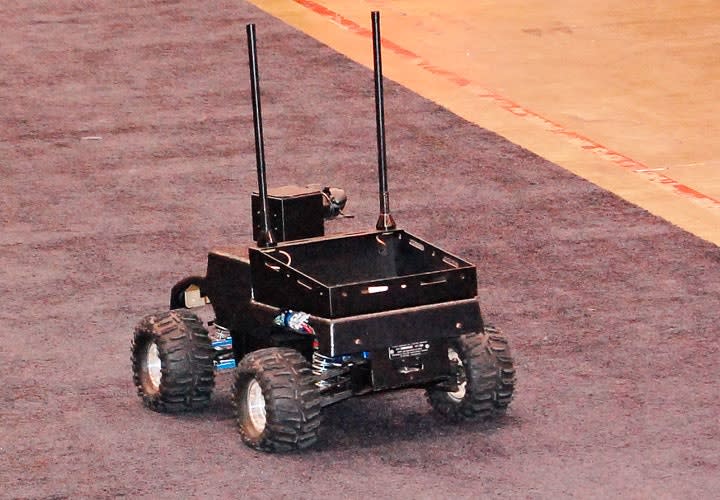There are times when what you need to see is out in the open, but you can't expose yourself to look without undue risk. This is a common problem for troops in Iraq and Afghanistan, where snipers and improvised explosive devices (IEDs) make hazardous duty of strolling around in the open. Many of the proposed solutions to this problem aren't far removed from radio-controlled toy trucks, with some improvements in endurance, range, durability, and the addition of a TV transmitter and camera.
One of the least-intimidating of these devices is the Recon Robotics' Scout Throwbot, which is the shape and size of a two-pound barbell. The "weight" portion of the barbell is actually the device's wheels and motor, and the camera, batteries, and antennae are on the connecting "bar." A stabilizing tail keeps the camera pointed forward and the antennas pointed up.
The whole device is 7.4 inches wide and three inches high, and weighs only 1.2 pounds, and it really is sturdy enough to throw into any environment you can walk into and be able to walk out. Its transmitter/receiver has a range of 100 to 300 feet and it moves at about one foot per second. The turnkey package, including control unit, chargers, and everything else you might need is $4,875.
If you would prefer a bird's eye view of your objective, there are quite a few radio-controlled aircraft capable of carrying TV cameras and transmitters. Quad-rotor aircraft use four helicopter-type propellers at the tips of a crossbar framework, with the props spinning in opposite directions to counteract torque. These take some practice to control precisely, but they're easier to master than traditional helicopter models, and they can hover as long as their battery will allow.
The Japanese Defense Ministry recently demonstrated a spherical aircraft that was built for about $1,400, using off-the-shelf components from hobby shops. The craft is a little larger than a basketball and is gyro-stabilized. In the demonstration video, the operator gives the hovering ball a shove and it returns to where it was, as if on an elastic cord. It was still able to dive and swoop over the indoor audience on command, and being round, it can land on any surface, right itself, and take off again unassisted. The effect looks like an anti-gravity device from a science-fiction film, but it's real and it carries a camera and transmitter.












